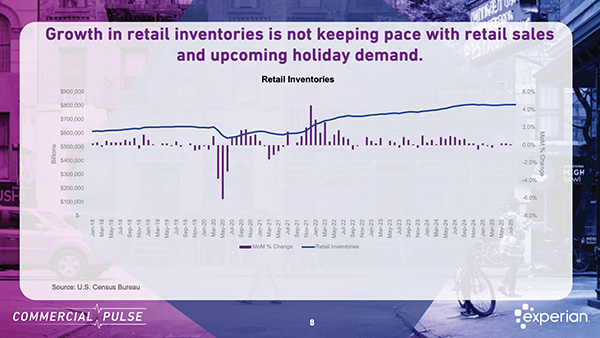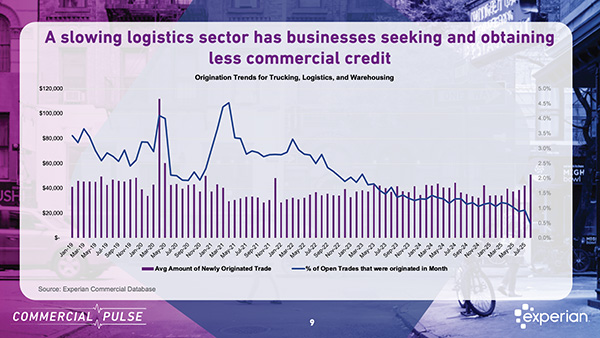Experian Commercial Pulse Report | 3/11/2025
After 26 months of decline, American manufacturing is making a comeback—led by the smallest players in the game. Small businesses are redefining an entire sector.
Watch Our Commercial Pulse Update
Green Shoots of Growth Seen in America’s Small Manufacturers
The U.S. manufacturing sector has been in a period of contraction for more than two years, but recent data suggests that a turning point may be on the horizon. The Purchasing Managers’ Index (PMI) reached 50.9 in January, breaking past the critical 50-point threshold for the first time in 26 months. This indicates that manufacturing activity is shifting from contraction to expansion, a positive sign for small businesses that have been a major driver of growth in the sector.
Over the past five years, the number of manufacturing businesses in the U.S. has grown by 13 percent, with small businesses leading the charge. Many of these businesses operate with fewer than nine employees and generate under $1 million in revenue, yet they now account for over 70 percent of commercial credit activity in the manufacturing sector.
This shift represents a significant change in an industry historically dominated by large, long-established firms. Small manufacturers are proving to be agile, innovative, and capable of carving out new opportunities in a challenging economic landscape.
Access to Credit is Key to Growth
One of the most striking trends in the sector is the increasing reliance on commercial credit cards. Since 2010, commercial card usage in manufacturing has surged by 37 percent. This suggests that small manufacturers are turning to flexible credit solutions to manage cash flow, finance equipment, and fund operational expenses.
Unlike traditional bank loans, commercial credit cards offer businesses quick access to funding with fewer restrictions, making them an attractive option for small manufacturers looking to scale operations. The consistent availability of credit will be a crucial factor in determining whether these businesses can sustain growth in the coming months.
What’s Driving the Manufacturing Sector’s Rebound?
Several factors contribute to the potential comeback of U.S. manufacturing, including:
- Stabilizing Consumer Demand – Although consumer confidence declined in February, retail sales have remained steady. With personal income rising, consumer spending could provide support for increased manufacturing output.
- Easing Cost Pressures – Rent inflation has slowed, and mortgage rates have dipped slightly, helping to stabilize business costs.
- Access to Credit Improving – With consumer delinquency rates stabilizing, lenders may loosen credit restrictions, giving small manufacturers greater access to working capital.
Challenges Still Remain
While the manufacturing sector is showing signs of a potential recovery, small businesses still face significant challenges.
- Economic Uncertainty – Inflation remains a concern, rising to 3.0 percent in January, marking the fourth consecutive month of increases.
- Labor Market Pressures – The unemployment rate remains low at 4.1 percent, meaning small manufacturers may struggle to hire skilled workers.
- Rising Interest Rates – While credit availability is improving, higher borrowing costs could limit expansion for some businesses.
Despite these hurdles, the resilience and adaptability of small manufacturers provide a strong foundation for future growth.
What This Means for Small Business Owners
For small manufacturers looking to capitalize on this potential expansion, there are a few key takeaways:
- Monitor Credit Options – As banks and lenders adjust lending policies, it’s essential to stay informed about financing opportunities that can support business growth.
- Invest in Efficiency – With cost pressures stabilizing, now is the time to invest in automation, technology, and process improvements that can boost productivity.
- Stay Agile – The manufacturing sector is cyclical, and market conditions can shift quickly. Flexibility and adaptability will be critical in the months ahead.
The U.S. manufacturing sector is at a crossroads. While uncertainty remains, the recent uptick in PMI, business credit activity, and commercial lending trends suggests that a shift toward expansion is underway. At Experian, we will continue to track these developments and provide insights to help small business owners make informed financial decisions.
To stay ahead of the latest trends:
✔ Visit our Commercial Insights Hub for in-depth reports and expert analysis.
✔ Subscribe to our YouTube channel for regular updates on small business trends.
✔ Connect with your Experian account team to explore how data-driven insights can help your business grow.
Want to learn more? Download the full Commercial Pulse Report for March 11, 2025.



